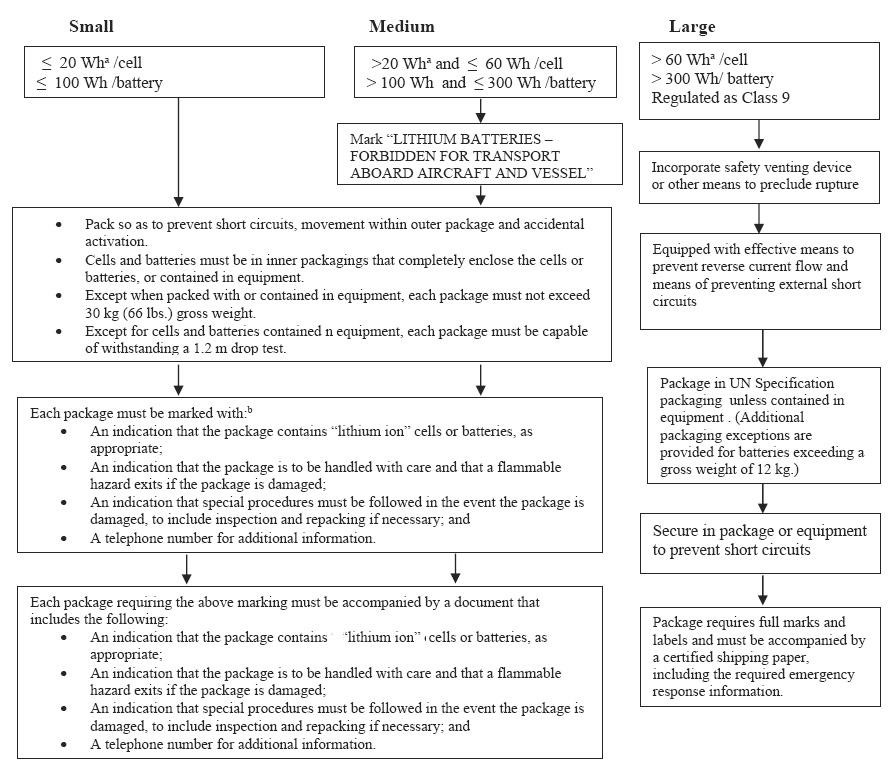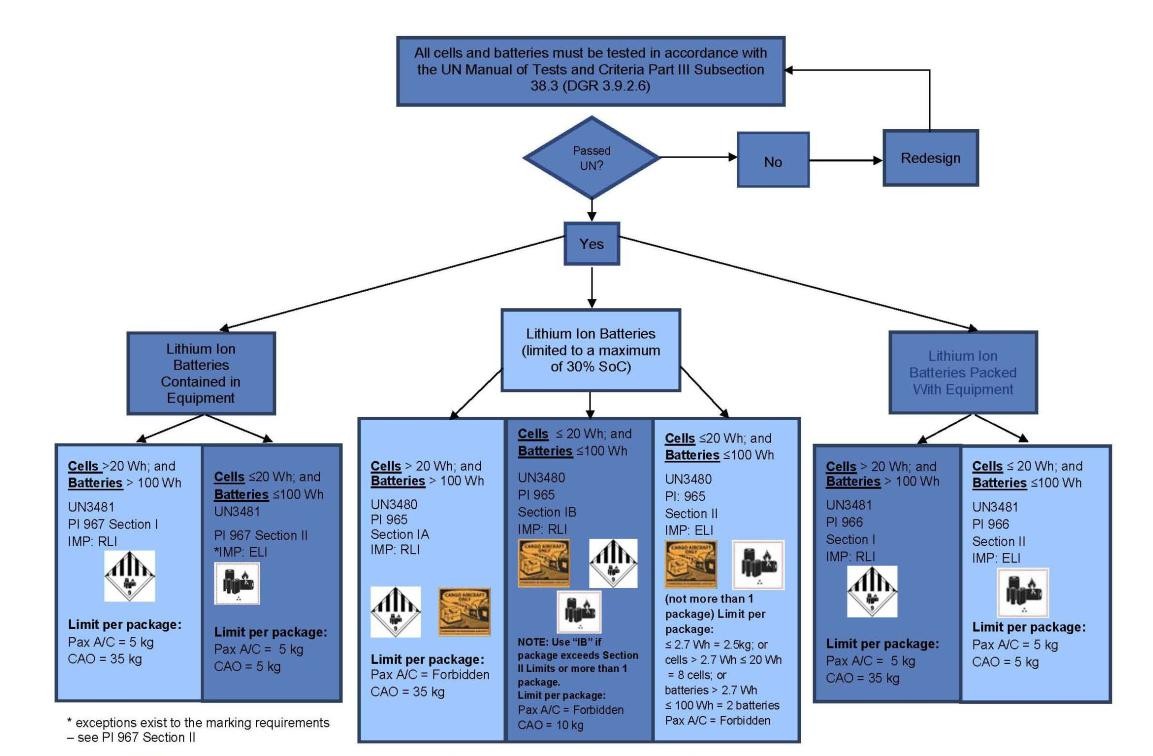Safety Data Sheets (SDSs)
Section 1 – Identification
Product Name: Lithium Ion/Lithium Polymer Rechargeable Battery (LiCoO2)
Manufacturer / Distributor Name: AA Portable Power Corp
Address: 825 S 19th Street, Richmond, CA 94804, Tel: 510-525-2328 Fax: 510-439-2808
Email: sales@batteryspace.com
Emergency Tel (Within USA and Canada): CHEMTREC 1-800-424-9300
Emergency Tel (Outside USA and Canada) for Shipment to USA: CHEMTREC +1 703-527-3887
Recommended Use: General use
Restrictions on Use: N/A
Section 2 – Hazard(s) Identification
Intact batteries present no specific hazards. If batteries show signs of leaking, AVOID skin or eye contact with the material leaking from the battery. If battery is burning, put out the fire by using right extinguisher.
Potential Health Hazards:
Eye: No particular hazards for proper use. It will cause severe irritation or chemical burn when batteries are broken.
Skin: No particular hazards for proper use. It will cause skin severe irritation by inhalation of EC and Routes of Entry: DMC or chemical burn when batteries are broken.
Inhalation: It will irritate breath system by being exposed to fumes when batteries are broken.
Ingestion: It is deleterious by swallowing battery. Broken batteries will cause severe chemical burn to mouth, esophagus and gastro enteric system
Environment hazards: It will cause different harms to man and environment.
Burning and exploding hazards: When the battery is short-circuited, over charged or over heated, it may cause electrolyte of the battery leaked out or the battery exploding.
Required Label Elements:N/A
Section 3 – Composition/Information on Ingredients
| Ingredient | Content (percent of total weight) |
CAS Index No. | EINECS |
|---|---|---|---|
| LithiumCobalt Oxide(LiCoO2) | 50% | 12190-79-3 | 235-362-0 |
| Carbon(Graphite) | 10% | 7782-42-5 | 231-955-3 |
| PP | 5 | 9003-07-0 | N/A |
| PVDF | 2 | 24937-79-9 | N/A |
| PE | 5 | 9002-88-4 | N/A |
| CMC | 0.5 | 9004-32-4 | N/A |
| LiPF6 | 5 | 21324-40-3 | 244-334-7 |
| EC | 5 | 96-49-1 | 202-510-0 |
| DMC | 5 | 616-38-6 | 210-478-4 |
| Ni | 2.5 | 7440-02-0 | 231-111-4 |
| Cu | 5 | 7440-50-8 | 231-159-6 |
| Al | 5 | 7429-90-5 | 231-072-3 |
Trade Secret Claims:N/A
Section 4 – First-aid Measures
Eye
Flush eyes with plenty of water for at least 15 minutes, occasionally lifting the upper and lower eyelids. Get medical aid.
Skin
Remove contaminated clothes and rinse skin with plenty of water or shower for 15 minutes. Get medical aid.
Inhalation
Remove from exposure and move to fresh air immediately. Use oxygen if available.
Ingestion
Give at least 2 glasses of milk or water. Induce vomiting unless patient is unconscious. Call a physician
Section 5 – Fire-fighting Measures
Hazard properties:
The battery may be over-heated by outside and interior short-circuit, and burning batteries may emit toxic fumes.
Hazardous Combustion products:
Metallic oxide, Carbon oxide(CO), Carbon dioxide(CO2), etc.
Extinguishing Media:
Species D fire extinguishers of chemical dry powder, yellow sands. Do not use water.
Firemen safeguard:
Firemen should wear fire-fighting suits with a self-contained breathing apparatus
Section 6 – Accidental Release Measures
Steps to be taken in case Material is Released or Spilled
If the battery is accidentally broken and organic electrolyte leaks out, wipe it up with a cloth, and dispose of it in a plastic bag and put into a steel can. The preferred response is to leave the area and allow the batteries to cool and vapors to dissipate. Provide maximum ventilation. Avoid skin and eye contact or inhalation of vapors. Remove spilled liquid with absorbent and incinerate.
Waste Disposal Method
It is recommended to discharge the battery to the end, to use up the metal lithium inside the battery, and to bury the discharged battery in soil.
Section 7 – Handling and Storage
Handling:
- Do not vibrate the battery excessively.
- Avoid short-circuiting the battery. Though short-circuit for little time will not influence badly the battery, short-circuit for long time will lose the battery’s energy and bring plenty of heat which will burn skin and cause fire or explosion indeed.
- The equipments of metal which are used for battery pack such as coin, metal accouterments, metal worktable, metal strip, etc. are source of short-circuit.
- It should be provide with effective measures to prevent short-circuit during transportation and storage.
- Do not disassemble and damage the battery.
- The battery should be transported with 10-50% charged states.
- Do not contact the battery with water.
- Do not store the battery in the place with point-blank sunshine.
- The battery should be 40-60% charged for long time storage.
- The battery should be stored in the place where is cool, dry and lee.
Storage:
- High temperature may cause the battery capability loss, leakage and rustiness.
- Do not expose the battery to fire.
- Store the battery away from moisture.
Section 8 – Exposure Controls / Personal Protection
Respiratory Protection
In case of battery venting, provide as much ventilation as possible. Avoid confined areas with venting batteries. Respiratory Protection is not necessary under conditions of normal use.
Ventilation
Not necessary under conditions of normal use.
Protective Gloves
Not necessary under conditions of normal use. Other Protective Clothing or Equipment Not necessary under conditions of normal use.
Personal Protection is recommended for venting batteries
Respiratory Protection, Protective Gloves, Protective Clothing and safety glass with side shields.
OSHA’s Permissible Exposure Limits (PELs): N/A
Threshold Limit Values (TLVs): N/A
Section 9 – Physical and Chemical Properties
Please refer most updated information by searching the product part# at www.batteryspace.com
Section 10 – Stability and Reactivity
Stability: Stable
Conditions to Avoid: Short-circuit, collision, refit, high temperature (over100°C), point-blank sun shine and high humidity environment.
Hazardous Decomposition Products: Toxic gas brought when burning.
Hazardous Polymerization: N/A.
Incompatibility (Materials to avoid): Electric materials, water, seawater, oxidant, acid.
Section 11 – Toxicological Information
Inhalation, skin contact and eye contact are possible when the battery is opened. Exposure to internal contents, the corrosive fumes will be very irritating to skin, eyes and mucous membranes. Overexposure can cause symptoms of non-fibrotic lung injury and membrane irritation.
Numerical Measures of Toxicity: No toxicity.
Section 12 – Ecological Information
Ecological toxicity:
The chemicals of the battery will cause harm to the environments if it is discarded to the surroundings.
Biodegradability: No information available.
Non-biodegradability: No information available.
Section 13 – Disposal Considerations
APPROPRIATE METHOD OF DISPOSAL OF SUBSTANCE OR PREPARATION
If batteries are still fully charged or only partially discharged, they can be considered a reactive hazardous waste because of significant amount of unreacted or unconsumed lithium remaining in the spent battery. The batteries must be neutralized through an approved secondary treatment facility prior to disposal as a hazardous waste. Recycling of battery can be done in authorized facility, through licensed waste carrier.
Section 14 – Transport Information
All cells and batteries (regardless small/medium/large batteries) must be proven to meet the requirement of each test in the UN Manual of Tests and Criteria.
- Wh = Watt-hours rating
- Does not apply to a package containing button cells installed in equipment or no more than four cells or two batteries installed in equipment
April 1st, 2016 – ICAO/IATA Air Regulations – Overpacking Li Ion and Lithium Metal Cells/Batteries
New ICAO/IATA regulations will prohibit the “Overpacking” of Section II cells and batteries under Packing Instructions 965 (Lithium Ion) and 968 (Lithium Metal). After April 1, 2016 air shipments under Section II of the regulations will be limited to one 2.5 kg package. Multiple 2.5 kg packages will not be allowed unless they ship as Class 9.
This change will have the largest impact on servicing direct customer base. While shipping lithium product by air will still be possible via Class 9 shipping, it will become more complicated and expensive. We highly recommend ordering within lead time so boat shipments can be used or maintaining inventory of the product.
April 1st, 2016 – ICAO/IATA Air Regulations – Li Ion State of Charge
New ICAO/IATA regulations will limit the State of Charge (SOC) to 30% for all lithium ion cells and batteries on both Passenger and Cargo aircraft. Please refer to Packing Instructions 965, Section 1A, 1B and Section II. This will impact just the shipment of cells and batteries by air, not the shipment of cells and batteries “packed with” or “contained in” equipment
Separate Li-ion batteries when shipping to prevent short-circuiting. They should be packed in strong packaging for support during transport. In the case of transportation, confirm no leakage and no overspill from a container. Take in a cargo of them without falling, dropping and breakage. Prevent collapse of cargo piles and wet by rain. The container must be handled carefully. Do not give shocks that result in a mark of hitting on a cell. Please refer to Section 7-HANDLING AND STORAGE also.
Section 15 – Regulatory Information
Law Information
《Dangerous Goods Regulation》
《Recommendations on the Transport of Dangerous Goods Model Regulations》
《International Maritime Dangerous Goods》
《Classification and code of dangerous goods》
IATA 2016 DGR 57th edition
49CFR 173.185
OSHA Hazard Communication Standard Status
Toxic Substances Control Act (TSCA) Status
SARA Title III
RCRA
In accordance with all Federal, State and Local laws.
Section 16 – Other Information
The above information is based on the data of which we are aware and is believed to be correct as of the data hereof. Since this information may be applied under conditions beyond our control and with which may be unfamiliar and since data made available subsequent to the data hereof may suggest modifications of the information, we do not assume any responsibility for the results of its use. This information is furnished upon condition that the person receiving it shall make his own determination of the suitability of the material for his particular purpose.
SDS Creation Date: September 23, 2015
SDS Revision Date: January 12, 2017



